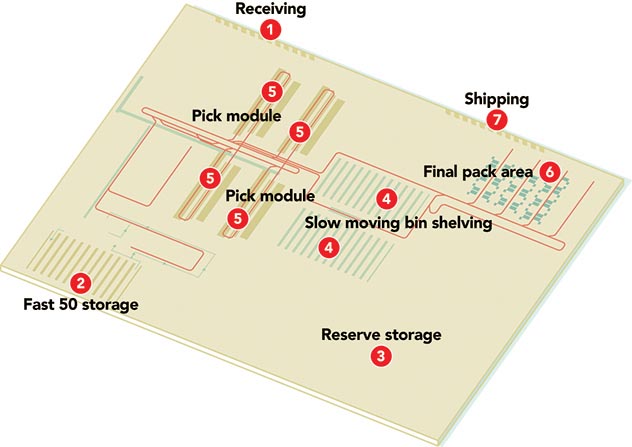Thrive Market: Keeping up with growth
Thrive Market’s new Indiana DC was designed to meet the needs of a fast-growing e-commerce startup today and tomorrow.
Thrive Market
Batesville, Indiana
Size: 361,000 square feet
Products: Focused on health and wellness, including food, beauty, pet and items for the home
SKUs: 4,000+
Throughput: 4,000 orders and 48,000 units per day
Employees: 150
Shifts per day/ Days per week: 2 shifts, Sunday through Thu
Scalability is the key attribute of Thrive Market’s new facility with software, automatic data collection, and conveyor and sortation designed to grow with the company’s sales.
Receiving:
The facility receives full truckload, LTL and parcel shipments in receiving (1). Inbound inventory is inspected and scanned into the warehouse management system (WMS). Most inventory will be palletized and staged for putaway in a Fast 50 storage area (2) for fast-moving items; reserve storage (3): or a shelving area for slow-moving, low-velocity picks (4).
Storage:
The WMS directs a lift truck operator to a location in one of the storage areas (2, 3, 4), and a pallet or carton is scanned to complete the putaway process.
Picking:
The facility is managed through a combination of WMS and warehouse execution software (WES). The WMS is a true management system: It is responsible for inventory control; tracks individual productivity; and is tied directly to the online ordering system and batches which man¬ages the flow of work through the facility. Items can be picked from several areas.

Fast 50:
In this area (2), the 50 fastest-moving SKUs—items that are included in almost every order—are stored. The system prints out an order, boxes are created manually and labeled and items are scanned into the box using a wrist-mounted computer and ring scanner.
Pick modules:
Cartons are conveyed from the Fast 50 area to one of four pick modules (5). Cartons are sorted to the first pick location for that order. Once the pick is complete, the carton is placed back on to the conveyor and is passed to the next pick location until all of the picks from the pick module for that order are complete.
Slow-moving items:
From the pick modules, cartons are diverted to a bin shelving area (4) for slow-moving items to complete the order.
Packing:
Once all of the items for an order have been picked, the carton is sent to packing (6), which is an intensive process to create a branded experience for the customer. The inside of the box is printed as is special water tape. All packaging material is sustainably sourced, including tissue liner and the dividers and material used to hand wrap breakable material. Packers include a hand-written thank you note. The invoice is added, along with a topper to provide a clean and neat sealed look. Once the box is taped, it is conveyed to the shipping area (7).
System Integration and Warehouse Execution System: Swisslog
Warehouse Management System: HighJump
Conveyor and Sortation: TGW
Pallet Rack: SpaceRak
Shelving: Tri-Boro Storage Products
Mobile Computing and Wrist mounted Scanner: Zebra Technologies (Motorola)
Lift Trucks: Crown
Packaging Materials: Ranpak and Storopak
Article Topics
Equipment Report News & Resources
Radial stays ahead of the automation curve Wireless Mobility: Ready for the next leg up AGVs set new standards for inventory transportation Inside North Shore Care Supply: Bringing robots to receiving Bergen Logistics: Putting robots to work in a multi-tenant facility High-tech meets low-tech: Automate storage for pallet loads Tuggers, carts work together to increase productivity and ergonomics More Equipment ReportLatest in Materials Handling
Materials Handling Robotics: The new world of heterogeneous robotic integration Lucas Watson appointed CSO for Körber’s Parcel Logistics business in North America Hyster recognizes Dealers of Distinction for 2023 Carolina Handling names Joe Perkins as COO C-suite Interview with Keith Moore, CEO, AutoScheduler.AI: MODEX was a meeting place for innovation Walmart deploying autonomous lift trucks at four of its high-tech DCs Coles shops big for automation More Materials HandlingAbout the Author
Subscribe to Materials Handling Magazine

Find out what the world's most innovative companies are doing to improve productivity in their plants and distribution centers.
Start your FREE subscription today.
April 2024 Modern Materials Handling

Latest Resources












